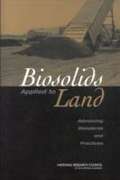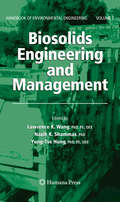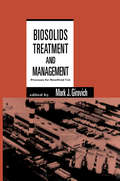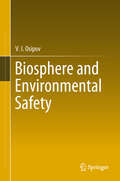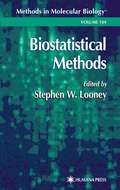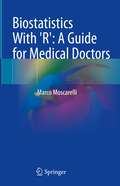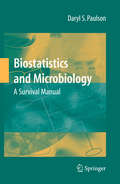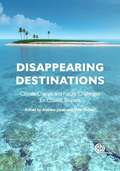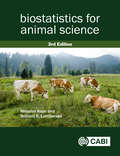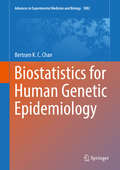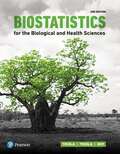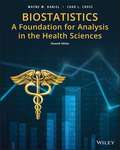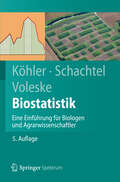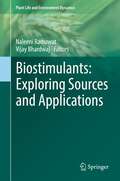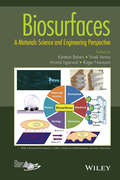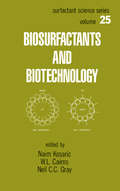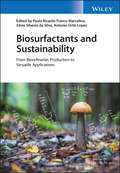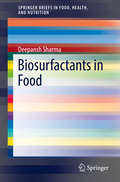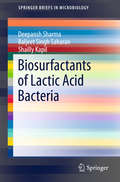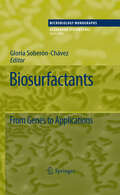- Table View
- List View
Biosolids Applied to Land: Advancing Standards and Practices
by National Research CouncilThe 1993 regulation (Part 503 Rule) governing the land application of biosolids was established to protect public health and the environment from reasonably anticipated adverse effects. Included in the regulation are chemical pollutant limits, operational standards designed to reduce pathogens and the attraction of disease vectors, and management practices. This report from the Board on Environmental Studies and Toxicology evaluates the technical methods and approaches used by EPA to establish those standards and practices, focusing specifically on human health protection. The report examines improvements in risk-assessment practices and advances in the scientific database since promulgation of the regulation, and makes recommendations for addressing public health concerns, uncertainties, and data gaps about the technical basis of the biosolids standards.
Biosolids Engineering and Management (Handbook of Environmental Engineering #7)
by Lawrence K. Wang Yung-Tse Hung Nazih K. ShammasThis is a collection of methods of practical design, calculation and numerical examples that illustrate how organized, analytical reasoning can lead to the discovery of clear, direct solutions to pollution especially in the areas of biosolids management, treatment, disposal and beneficial use. The book contains an extensive collection of detailed design examples and case histories, and a distinguished panel of authors provides insight into a range of topics.
Biosolids Treatment and Management: Processes for Beneficial Use (Environmental Science & Pollution)
by Mark J. GirovichThis work details the economic, regulatory and environmental protection issues related to biosolids management and use. It evaluates current treatment technologies and management strategies for the beneficial utilization of municipal wastewater residuals. Cost information regarding the relative economic merits of special reuse and disposal methods,
Biosphere Reserves and Sustainable Development Goals 1: Scientific and Practical Educational Issues in the Mediterranean
by Angela Barthes Bruno Romagny Catherine CibienSince 1971, UNESCO's Man and the Biosphere (MAB) Programme has embraced a number of principles that link the political, scientific and academic spheres. Biosphere Reserves and Sustainable Development Goals 1 presents these areas as privileged spaces for experimenting with operating methods specific to cross-cutting objectives and issues. These areas encourage the development of interdisciplinary research, supported by a worldwide network to disseminate experience, approaches and knowhow. The various global and local political scales are linked here, with different consequences for the reconfiguration of local political arenas, for specific modes of development linked to a renewed relationship with knowledge, powers and institutions, and for renewed relationships between the worlds of science, education and territorial governance.
Biosphere Reserves and Sustainable Development Goals 2: Issues, Tensions, Processes and Governance in the Mediterranean
by Angela Barthes Bruno Romagny Catherine CibienSince 1971, UNESCO's Man and the Biosphere (MAB) Programme has embraced a number of principles that link the political, scientific and academic spheres. Biosphere Reserves and Sustainable Development Goals 2 is a reminder of the fundamental issues involved in governance. The diversity and multiplicity of stakeholders, and the complexity of the interplay between them, as well as their organization, are decisive factors in the proper management of resources and territories. The book also presents a number of case studies demonstrating that, between the strong development aspirations of their populations, the impact of human activities and the need to conserve their biological heritage, the biosphere reserves of the southern Mediterranean are facing major issues: agricultural pollution, forest fires, water use in a context of climate change, etc.
Biosphere and Environmental Safety
by V. I. OsipovThis book analyses the state of the natural environment and the causes of its degradation using the biosphere approach. Further, those issues that must be resolved immediately on the global level are identified following the ideas defined by V.I. Vernadsky, and new principles of Man-Nature interaction are pursued. The modern world currently faces three global trends inducing biosphere degradation and the aggravation of ecological hazards, namely: a) rapid and uncontrolled growth of human population on the Earth and insufficient natural resources to sustain it; (b) technogenesis development; and (c) global climate change and the aggravation of natural disasters. Ecological safety and military security are becoming the crucial conditions for the survival of modern civilization. To mitigate the ecological strain on the Earth, the technogenesis strategy should be changed and many other pressing issues must be resolved. These problems should be addressed using the biosphere approach, because the individual human being is the biosphere constituent, and his or her safety cannot be provided without maintaining the entire natural system on our planet.
Biostatistical Design and Analysis Using R: A Practical Guide
by Dr Murray LoganR — the statistical and graphical environment is rapidly emerging as an important set of teaching and research tools for biologists. This book draws upon the popularity and free availability of R to couple the theory and practice of biostatistics into a single treatment, so as to provide a textbook for biologists learning statistics, R, or both. An abridged description of biostatistical principles and analysis sequence keys are combined together with worked examples of the practical use of R into a complete practical guide to designing and analyzing real biological research. Topics covered include: simple hypothesis testing, graphing exploratory data analysis and graphical summaries regression (linear, multi and non-linear) simple and complex ANOVA and ANCOVA designs (including nested, factorial, blocking, spit-plot and repeated measures) frequency analysis and generalized linear models. Linear mixed effects modeling is also incorporated extensively throughout as an alternative to traditional modeling techniques. The book is accompanied by a companion website www.wiley.com/go/logan/r with an extensive set of resources comprising all R scripts and data sets used in the book, additional worked examples, the biology package, and other instructional materials and links.
Biostatistical Methods (Methods in Molecular Biology #184)
by Stephen W. LooneyLeading biostatisticians and biomedical researchers describe many of the key techniques used to solve commonly occurring data analytic problems in molecular biology, and demonstrate how these methods can be used in the development of new markers for exposure to a risk factor or for disease outcomes. Major areas of application include microarray analysis, proteomic studies, image quantitation, genetic susceptibility and association, evaluation of new biomarkers, and power analysis and sample size.
Biostatistics With 'R': A Guide for Medical Doctors
by Marco MoscarelliThis book aims not only to introduce fundamental biostatistics topics but to explain them through R-project (R-studio). 'R' is perhaps the more used statistical software in the medical field. It is structured as a 'scientific journey' and comes with a sham yet realistic dataset ready to be analysed. The dataset along with the R-script can be downloaded from GitHub, and each chapter has dedicated scripts that will enhance the understanding of R and biostatistics. Specifically designed for whoever works in the medical-academic environment, this practical guide will help the reader to become familiar with basic to advanced biostatistics topic (descriptive - analysis / regression etc.) and to gain solid knowledge of R.
Biostatistics and Microbiology: A Survival Manual
by Daryl S. PaulsonThis "nuts and bolts" book provides a condensation of biostatistical methods that applied microbiology researchers need to perform data analyses. Based on the author's more than two decades of applied research and teaching experience, it is presented in a straight-forward manner, applicable by practicing microbiologists with minimal backgrounds in mathematics. All methods rely only on the use of a basic hand-held calculator. The overriding goal of this book is to ground one's microbiological expertise and experience in one's research pursuits, using biostatistics not as a black box, but as a tool.
Biostatistics for Animal Science
by William Lamberson Miroslav KapsDesigned to cover techniques for analysis of data in the animal sciences, this textbook provides an overview of the basic principles of statistics enabling the subsequent applications to be carried out with familiarity and understanding, followed by more complex applications and detailed procedures commonly used in animal sciences. Each chapter begins by introducing a problem with practical questions, followed by a brief theoretical background, and is supplemented with an abundance of examples in SAS from animal sciences and related fields. Key features: New larger format and updated throughout Covers both basic techniques and more complex procedures Contains exercises for readers to work through
Biostatistics for Animal Science, 3rd Edition
by Miroslav Kaps William R. LambersonDesigned to cover techniques for analysis of data in the animal sciences, this popular textbook provides an overview of the basic principles of statistics enabling the subsequent applications to be carried out with familiarity and understanding. Each chapter begins by introducing a problem with practical questions, followed by a brief theoretical background. Most topics are followed up with numerical examples to illustrate the methods described using data-sets from animal sciences and related fields. The same examples are then solved using the SAS software package. Key features of this third edition: - Updated throughout, and covers a wealth of new distributions and new material on non-normal dependent variables - Improved clarity of text and examples - Includes both basic techniques and more complex procedures to provide an essential resource whatever your level - Contains exercises and many worked examples in SAS. Written primarily for students and researchers in animal sciences, the text is also useful for those studying agricultural, biological, and veterinary sciences.
Biostatistics for Bioassay (Chapman & Hall/CRC Biostatistics Series)
by Matthew Stephenson Ann YellowleesIn recent decades, there has been enormous growth in biologics research and development, with the accompanying development of biological assays for emerging products. In parallel, there have been substantial advances in statistical methodology, as well as technological advances in computer power, enabling new techniques to be implemented via statistical software. Biostatistics for Bioassay presents an overview of the statistical analysis techniques that are needed in order to report the results of biological assays. These assays are needed for testing all biological medicines, such as vaccines and cell therapies, to allow them to be released for use. Beginning with consideration of the performance characteristics required of a bioassay, including accuracy, precision, and combinations of these two attributes, the book builds a framework for statistical bioassay design.Features: Explains the statistical methods needed at each stage of the lifecycle of a bioassay Describes the demonstration of the bioassay’s performance, known as validation Covers the statistical techniques for monitoring the bioassay’s performance over time Details how to transfer the bioassay to another laboratory or replace critical reagents Provides examples at every stage, to allow the reader to work through the techniques and consolidate their understanding The book provides a resource for interested bioassay analysts, and statisticians working with bioassays. In bringing together best practices in statistics across the bioassay lifecycle into a single volume, it aims to provide a comprehensive and useful textbook for statistical analysis in bioassay.
Biostatistics for Human Genetic Epidemiology (Advances in Experimental Medicine and Biology #1082)
by Bertram K. ChanThe book illustrates how biostatistics may numerically summarize human genetic epidemiology using R, and may be used successfully to solve problems in quantitative Genetic Epidemiology Biostatistics for Human Genetic Epidemiology provides statistical methodologies and R recipes for human genetic epidemiologic problems. It begins by introducing all the necessary probabilistic and statistical foundations, before moving on to topics related human genetic epidemiology, with R codes illustrations for various examples. This clear and concise book covers human genetic epidemiology, using R in data analysis, including multivariate data analysis. It examines probabilistic and statistical theories for modeling human genetic epidemiology – leading the readers through an effective epidemiologic model, from simple to advanced levels. Classical mathematical, probabilistic, and statistical theory are thoroughly discussed and presented. This book also presents R as a calculator and using R in data analysis. Additionally, it covers Advanced Human Genetic Data Concepts, the Study of Human Genetic Variation, Manhattan Plots, as well as the Procedures for Multiple Comparison. Numerous Worked Examples are provided for illustrations of concepts and real-life applications. Biostatistics for Human Genetic Epidemiology is an ideal reference for professionals and students in Medicine (particularly in Preventive Medicine and Public Health Medical Practices), as well as in Genetics, Epidemiology, and Biostatistics.
Biostatistics for The Biological and Health Sciences
by Mario F. Triola Marc M. Triola Jason RoyReal-world applications connect statistical concepts to everyday life. This book uses a variety of real-world applications to bring statistical theories and methods to life. Through these examples and a friendly writing style, the 2nd Edition ensures that you understand concepts and develop skills in critical thinking, technology, and communication. The result of collaboration between a biological sciences expert and the author of the #1 statistics book in the country, Biostatistics for the Biological and Health Sciences provides an excellent introduction to statistics for readers interested in the biological, life, medical, and health sciences.
Biostatistics: A Foundation For Analysis In The Health Sciences
by Wayne W. Daniel Chad L. CrossThe ability to analyze and interpret enormous amounts of data has become a prerequisite for success in allied healthcare and the health sciences. Now in its 11th edition, Biostatistics: A Foundation for Analysis in the Health Sciences continues to offer in-depth guidance toward biostatistical concepts, techniques, and practical applications in the modern healthcare setting. Comprehensive in scope yet detailed in coverage, this text helps students understand—and appropriately use—probability distributions, sampling distributions, estimation, hypothesis testing, variance analysis, regression, correlation analysis, and other statistical tools fundamental to the science and practice of medicine.
Biostatistik: Eine Einführung für Biologen und Agrarwissenschaftler (Springer-Lehrbuch)
by Gabriel Schachtel Peter Voleske Wolfgang KöhlerDie Auswertung experimenteller Ergebnisse ist für Biologen und Agrarwissenschaftler ein wichtiges Handwerkszeug. Mit dieser gut verständlichen Einführung in Grundlagen und Anwendungen der Biometrie ist ein schneller Einstieg in die Statistik möglich. Soweit wie möglich wird ohne Formeln und mathematische Symbolik die hinter den Verfahren stehende Grundidee komplexer statistischer Verfahren erläutert. Die 5. Auflage enthält zusätzlich Schemata zur Versuchsplanung und Auswertung sowie ein erweitertes Glossar englischer Fachausdrücke.
Biostimulants: Exploring Sources and Applications (Plant Life and Environment Dynamics)
by Naleeni Ramawat Vijay BhardwajThis edited book is a comprehensive compilation highlighting sources of biostimulants, their production, influence on plant growth and development, and regulatory status of plant biostimulants for better understanding and opening new vistas for future research. Biostimulants, the biological formulations are known to meliorate the plants growth and vigour, improve nutritional efficiency along with maintaining their well-being mainly via providing protection against a wide range of infections. Both horticultural as well as agricultural crops involve the utilization of the biostimulants. Fulvic and humic acids, nitrogen-containing compounds, protein hydrolysates, favourable bacteria and fungi, and extracts of seaweed are the chief active components of these. The major driving force for these materials is the organic farming industry and demand for sustainable crop production. This book will be of great interest to researchers, teachers, climate change scientists, capacity builders, and policy makers. Moreover, this book does the work of a supplementary reading for students in various fields such as agriculture, soil science, ecology, environmental science and forestry at undergraduate as well as graduate level. This will be a gainful read for national and international agricultural scientists and the policy makers.• Elaborates on biostimulants induced influence of plant growth and development • Covers all aspects of biostimulants sources and its role in plant life in detail • Discusses evidence based approach in biostimulants sources and its useful applications in plants
Biosurfaces
by Roger Narayan Kantesh Balani Arvind Agarwal Vivek VermaIdeal as a graduate textbook, this title is aimed at helpingdesign effective biomaterials, taking into account the complexinteractions that occur at the interface when a synthetic materialis inserted into a living system. Surface reactivity,biochemistry, substrates, cleaning, preparation, and coatingsare presented, with numerous case studies and applicationsthroughout. Highlights include:Starts with concepts and works up to real-life applicationssuch as implantable devices, medical devices, prosthetics, and drugdelivery technologyAddresses surface reactivity, requirements for surface coating,cleaning and preparation techniques, and characterizationDiscusses the biological response to coatingsAddresses biomaterial-tissue interactionIncorporates nanomechanical properties and processingstrategies
Biosurfactants and Biotechnology (Surfactant Science Ser. #25)
by KosaricHere is the first comprehensive reference to examine microbial surface active agents (biosurfactants)and biological emulsifiers as applied in biotechnology and other industries.Biosurfactants and Biotechnology highlights state-of-the-art uses of these agents, and incorporatesa wealth of ideas for future research and development related to feedstocks, production,and processing. The book delineates the chemistry, biochemistry, mechanisms, and propertiesof biosurfactants and biological emulsifiers .. . critically assesses their role in enhanced oil recoveryand other industrial applications . .. and includes numerous references to the literature.Biosurfactants and Biotechnology is an invaluable guide for physical, surface, and colloidchemists working on or with surfactants, interfacial phenomena, and cell-surface physiology ;petrochemical, chemical, biochemical, petroleum, and pollution control engineers; pharmacologists,cosmetic scientists, food scientists, and microbiologists. It is also an important resourcefor graduate students in these fields.
Biosurfactants and Sustainability: From Biorefineries Production to Versatile Applications
by Paulo Ricardo Franco Marcelino Silvio Silverio da Silva Antonio Ortiz LopezBiosurfactants and Sustainability A timely and authoritative collection of resources on the sustainable production of biosurfactants In Biosurfactants and Sustainability, a team of distinguished researchers presents emerging themes in the rapidly evolving field of biosurfactants. The editors have chosen work that focuses on biosurfactants as eco-friendly and versatile compounds of interest in societies seeking sustainable forms of development. The book examines biosurfactants in the context of biorefineries and in the exploration of extremophilic microorganisms for biosurfactant production. The included works discuss biosurfactant production from different lignocellulosic and amylaceous raw materials, as well as oilseeds and other agro-industrial byproducts. Readers will also find: A thorough introduction to microorganisms producing biosurfactants, as well as sustainable biosurfactant production in biorefineries Comprehensive explorations of the challenges of biosurfactant production in fermentation processes Practical discussions of bioreactors and metabolic engineering used in biosurfactant production Fulsome treatments of biosurfactant production using enzyme and novel biosurfactant applications in nanotechnology, health, agriculture, and environmental cleanup Perfect for researchers and professionals with an interest in biosurfactant application and biotechnology processes, Biosurfactants and Sustainability will also benefit academic researchers, industry scientists, and engineers in biotechnology, microbiology, biomass conversion, environmental science and engineering.
Biosurfactants for the Biobased Economy (Advances in Biochemical Engineering/Biotechnology #181)
by Rudolf Hausmann Marius HenkelThis book provides a comprehensive overview of current biosurfactant research and applications. Public awareness of environmental issues has increased significantly over the last decade, a trend that has been accompanied by industry demands for climate-friendly and environmentally friendly renewable raw materials. In the context of household products, biosurfactants could potentially meet this demand in the future due to their low ecotoxicity, excellent biodegradability, and use of renewable raw materials. The diversity of this class of molecules, which has only been marginally tapped to date, offers only an inkling of their future application potential. However, there are two main obstacles to their widespread commercial use on the growing surfactant market: the lack of attractive and competitive production technologies, and the limited structural diversity of commercially available biosurfactants. Addressing both of these core issues, this book will provide readers with a deeper understanding of the role of biosurfactants, including future opportunities and challenges.
Biosurfactants in Food (SpringerBriefs in Food, Health, and Nutrition)
by Deepansh SharmaThe present work aims to cover the perspectives of biosurfactants, which can be of interest in food-related industries and biomedical applications. Biosurfactants are a structurally diverse group of surface-active molecules extensively produced by bacteria, yeast and fungi. Despite having significant potential associated with emulsion formation, anti-adhesive and antimicrobial activities, considerably few applications have been reported regarding applications of biosurfactants in food formulations and processing. The utilization of biosurfactants, which are highly functional in food and biomedical applications, has become more and more significant. Along with providing an overview of biosurfactant properties, the book suggests how these properties could be applicable in the food industry.
Biosurfactants of Lactic Acid Bacteria (SpringerBriefs in Microbiology #0)
by Deepansh Sharma Baljeet Singh Saharan Shailly KapilThis book provides an introduction to biosurfactants produced by lactic acid bacteria, presenting a detailed compilation of their functional properties and structural composition. Microbial surfactants, extensively known as surface-active agents, have created a niche for themselves in the green-chemicals market, thanks to their distinct environment-friendly properties. The demand for biosurfactants in the cosmetics, food, pharmaceuticals, agricultural and environmental industries is steadily growing, and biosurfactants from lactic acid bacteria possess significant biological properties, making them potentially suitable for antimicrobial, anti-adhesive and various other industrially important applications. Exploring these aspects in depth, the book offers a valuable resource for both postgraduate students and researchers in the fields of food and industrial microbiology.
Biosurfactants: From Genes to Applications (Microbiology Monographs #20)
by Gloria Soberón-ChávezBiosurfactants, tensio-active compounds produced by living cells, are now gaining increasing interest due to their potential applications in many different industrial areas in which to date almost exclusively synthetic surfactants have been used. Their unique structures and characteristics are just starting to be appreciated. In addition, biosurfactants are considered to be environmentally "friendly," relatively non-toxic and biodegradable. This Microbiology Monographs volume deals with the most recent advances in the field of microbial biosurfactants, such as rhamnolipids, serrawettins, trehalolipids, mannosylerythritol lipids, sophorolipids, surfactin and other lipopeptides. Each chapter reviews the characteristics of an individual biosurfactant including the physicochemical properties, the chemical structures, the role in the physiology of the producing microbes, the biosynthetic pathways, the genetic regulation, and the potential biotechnological applications.
